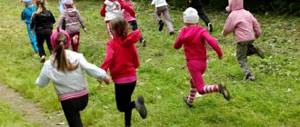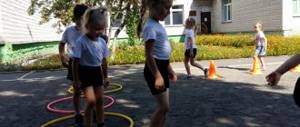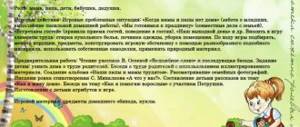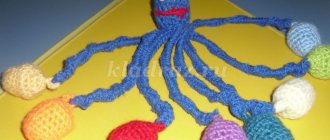Bashkir folk games for preschoolers
Alfiya Khusniyarova
Bashkir folk games for preschoolers
1. Kurai (Pipe)
The game is played to any Bashkir folk melody . Children, holding hands, form a circle and move in one direction. In the center of the circle there is one child, he is a kuraist, in his hands he has a kurai (a long pipe, he walks in the opposite direction.
Children walk in a circle, run, and perform footsteps to the words:
“We heard our kurai, we all gathered here.
Having played enough with the kuraist, they ran away in all directions.
Hai, hai, hai, hai! On the green, in the meadow
We'll dance to the Kurai,
Children scatter around the playground, performing the movements of the Bashkir dance to the words : “You, perky kurai, play more fun.
Choose those who dance better"
The child-kuraist chooses the best performer of the movements, who becomes the driver.
Rules: run away only after finishing the words.
2. Besei menen syskan (Cat and mice)
The cat sits in a circle on the edge of the area, eyes closed. Children - mice run around the playground very quietly, on their toes, so as not to wake up the cat. As soon as the cat opens its eyes and gets up, the mouse children should sit down and not move.
The cat says the words: “The cat went out for a walk, to catch gray mice.
Now I’ll catch up, grab it and swallow it.”
After finishing the words, the cat catches the mice, which get up and run away from him. At the end of the game , the number of mice caught is counted. A new cat is chosen and the game is repeated.
Rules: do not move while the cat is speaking; The greasy mice should stop playing and gather in the cat's house.
3. Muyush alysh (Corners)
At the four corners of the platform there are four chairs, with four children on them. The driver stands in the center. He approaches those sitting in turn and asks each person a question:
- Mistress, can I heat your bathhouse?
1 player answers: “My bathhouse is busy”
.
Player 2 answers: “My dog has given birth”
Player 3 answers: “The stove collapsed”
Player 4 answers: “There is no water”
The driver goes to the center of the site, claps his hands three times and shouts:
Hop, hop, hop!
During this time, the owners quickly change places. The driver must have time to take a free chair.
Rules: change only after the driver claps.
The game can also be played with a large number of children: in this case, the teacher should set up as many chairs as there are players and compose additional answers for the “owners”
.
4. Ak tirek, kuk tirek (White poplar, blue poplar)
Children stand in two lines along the edge of the playground opposite each other.
The first team asks in unison: “White poplar, blue poplar, what is in the sky?”
The second team answers in unison: “Motley birds”
.
The first team asks: “What do they have on their wings?”
The second team answers: “There is sugar and honey.”
.
The first team asks: “Give us sugar.”
.
The second team asks: “Why do you need it?”
The first team calls: “White poplar, blue poplar”
.
The second team asks: “Which of us do you choose?”
The first team calls the name of one of the players from the opposing team. The selected child runs towards the line of opponents, who stand with their hands tightly clasped, and tries to break the “chain”
opponent.
If he breaks the “chain”
, then he takes the player from the opposing team to his team, if not, then he remains in this team.
The team with the most players wins.
5. Bure menen kuyan (Wolf and hares)
for the game . The rest of the children are hares. The wolf hides - crouches on one side of the area, and the children - the hares - stand on the other side of the area, limited by a line. To the words of the presenter “hares”
leave the house and jump on two legs all over the site: “White hare, a soft hare has come to visit us.
The ears are long, the tail is short.”
At the signal from the presenter "Bure"
(
"Wolf"
, the hare children quickly return to their home by jumping, and the wolf tries to catch as many children as possible.
Rules: you can move around the site only by jumping on two legs; run into the house only after the driver’s signal; catch by touching the player with your hand.
6. Buken kayysh (Catch a sparrow with a belt)
Children stand in pairs in a circle: in front is a girl, behind is a boy. The driver, who has a belt (rope) in his hand, walks around the circle and says the text:
“Summer has passed, autumn has come, the ducks have flown away, the geese have flown away.
The nightingales sang. Crow stop! Sparrow fly!
The child who was chosen as a “sparrow”
runs away from the driver in a circle, and he tries to catch up and show off his belt. If the driver makes a sound, he takes the place of the player, and the person who makes the show becomes the driver.
Rules: do not touch the runner with your hand, but only with your belt. Run away after the word "fly"
.
7. Kugarsen (Pigeons)
Two parallel lines are drawn on the site at a distance of 5-8 meters, circles are drawn along these lines ( “nests”
).
Children stand in circles ( "nests"
) in front of each other.
Driver - “shepherd”
, with closed eyes, walks between the ranks and pronounces the text three times:
“Gur - gur, pigeons are one nest for all of us.”
With the end of the words, the children change places ( “nests”
) - run to opposite
“nests”
.
The shepherd opens his eyes and tries to occupy the empty “nest”
.
Left without a “nest”
the child
"dove"
becomes
a "shepherd"
.
Rules: you can change places only when the shepherd says the text three times.
8. Ena menyan ep (Needle and thread)
Children are divided into two teams, lined up in columns one behind the other on one side of the site. (cube, tower, flag) is placed in front of each team at a distance of 5 meters.
.
At the signal, the first players ( "needles"
) run around landmarks and return to the team.
The next player is hooked to them ( “thread”
, they run around the landmark together.
Thus, all team players ( "threads"
, taking turns catching on to each other, they run around landmarks.
That team wins ( "needle and thread"
, all the players of which caught on and ran around the landmarks first.
Rules: players are not allowed to unclasp their hands while running.
If this happens, the team that violated the rules starts the game again.
9. Yurt (Tirme)
The game involves four subgroups of children, each of which forms a circle at the corners of the site. In the center of each circle there is a chair on which a scarf is hung
with a national pattern. Holding hands, everyone walks in four circles at alternating steps and sings:
We, cheerful guys, will all gather in a circle.
Let's play, and dance, and rush to the meadow.
To a melody without words, the guys move in alternating steps into a common circle.
At the end of the music, they quickly run to their chairs, take a scarf and pull it over their heads in the form of a tent (roof, it turns out to be a yurt.
Rules of the game . When the music ends, you need to quickly run to your chair and form a yurt. group of children to build a yurt wins .
10. Copper stump (Bakir buken)
The owner of the copper stump is chosen, a skullcap is placed on his head, and he sits in the center of the circle on the stump
(chair)
.
The rest of the children stand in a circle - they are buyers.
1 hour of music: the owner walks in a circle and looks carefully at the children, as if choosing a mate. And the children are dancing at this time (improvisation of a national dance)
.
At the end of 1 hour. music owner takes off his skullcap and puts it on the “stump”
, then approaches one of the buyers. The buyer asks the owner:
“I want to ask you, can I buy your stump?”
The owner answers:
“If you are a daring horseman, the copper stump will be yours!”
The owner and the buyer go out of the circle, stand with their backs to each other and respond to the children’s words:
“1,2,3 – run!”
scatter in different directions.
who comes running first and takes the stump, while putting a skullcap on his head, wins The game is repeated with a new buyer.
10. Throwing stick (Soyosh tayak)
A circle with a diameter of 1.5 m is drawn. A throwing stick 50 cm long is placed in the circle.
The shepherd is chosen as the reader. One player throws a stick into the distance. The shepherd runs out to pick up an abandoned stick. At this time, the players are hiding. The shepherd returns with the stick, puts it back and looks for the children. Having noticed the one hiding, he calls him by name. The shepherd and the named child run to the stick. If the player comes running before the shepherd, then he takes the stick and throws it again, and hides again. If the player arrives later, he becomes a prisoner. He can only be rescued by a player who calls his name and manages to take the stick before the shepherd. When everyone is found, the one who was discovered first becomes the shepherd.
Rules of the game . You can start looking for players only when the stick is found and placed in the circle. The player called by name must immediately come out of hiding. The prisoner is saved by the player who reaches the stick before the shepherd.
11. Sticky stumps (Yebeshkek bukender)
Three or four players squat as far apart as possible. They represent sticky stumps. The rest of the players run around the court, trying not to come close to the stumps. The stumps should try to touch the children running past. The greasy ones become stumps.
Rules of the game . Stumps should not get out of place.
12. Shooter (Uksy)
Two parallel lines are drawn at a distance of 10 - 15 m from each other.
A circle with a diameter of 2 m is drawn in the middle between them. One player is the shooter.
He stands in a circle with a ball in his hands. The remaining players begin to run from one line to another. The shooter tries to hit them with the ball. The one who is hit becomes the shooter.
Rules of the game . At the beginning of the game , the shooter becomes the one who, after the sudden command “Sit!”
sat down last.
The moment of throwing the ball is determined by the shooter himself. The ball is thrown wide, the players throw the arrow. If a player catches a ball thrown at him, this is not considered a hit.
13. “TRANSFER THE EGG IN A SPOON”
.
Description of the game .
The game is organized in the form of a relay race: 2 people or 2 teams compete with each other. You need to, holding a wooden spoon with a boiled egg in your hand, run to the counter, run around it and return to the finish line, i.e. pass the baton to someone else. Who is faster? Moreover, the egg should not fall and should not be touched with your hands.
14. “WHO WILL DRESS UP FAST?”
Goal: to introduce children to items of national clothing: haraus, vest, boots (sitek, camisole, skullcap.
Description of the game .
The game is played in a competitive form, i.e. who can dress up the fastest! Having finished dressing up, you need to perform several dance moves to cheerful music (improvising a national dance)
.
Galileo.Pro
“The sea is agitated” - Russian folk game
This game can be played indoors. According to the counting rhyme, the guys choose a driver, then they make up chairs (there should be fewer of them than the guys) and according to the driver’s exclamation “The sea is worried” - they run, jump, pretending to be waves. At the driver’s signal, “The sea has calmed down,” they rush to take their seats. To those who did not get a seat, the driver assigns forfeits - asks them to dance, sing, read a poem.
The sea is agitated in front of me, Wave after wave hits the shore. This wave is not very strong, This wave is stronger than an elephant!
"White stick" - Tajik game
According to the counting rhyme, children choose a driver and are divided into 2 teams. Unbeknownst to the children, the driver hides a “white stick” (you can wrap a pencil in paper). At the driver’s sign, everyone runs to look for the wand; the one who finds the wand shouts: “Yes!” and tries to take it to a pre-agreed place, for example, to a circle drawn on the ground. The players of his team help him, and the guys from the other team try to take the stick away. The wand cannot be thrown, it can only be transferred.
The wand is a lifesaver, our game is ahead! The wand is a lifesaver; whoever misses it, drive! The wand is a lifesaver, you can hear hubbub and laughter, The wand is a lifesaver, help everyone, everyone, everyone!
“Collect apples” - Turkmen game
One apple is placed on a stool. The guys take turns taking the ball and throwing it up. While the ball touches the ground, you need to collect the “harvest” - take an apple from the stool. Those who succeed continue the game - put two, three, four apples on the stool, etc. The one who was able to collect more apples while the ball was in the air wins. Instead of apples, you can take pebbles, plum pits and other items.
Guess, Fatimushka, what’s in grandma’s bag: Bulbs? Buttons? Rice? Or flour? If you guess, grandma will give you a red, cheeky apple from a full bag!
"Rope walker" - Uzbek game
On the site, the guys draw a straight line 6-10 meters long. You have to move along it like on a tightrope. It is allowed to keep your arms at your sides. The losers are those guys who go off the line - “fly off the rope”
There is a tight rope hanging, Walk on, Farhad, you first. Then Sharaf, then Rashid, then Ilya, then me!
"Father Frost" - Belarusian game»
Ved: White fluff, snow fluff - everything, everything, everything is fluff all around!, fluff on hats, fluff on fur coats, fluff on eyebrows, fluff on lips. How ticklish, wow! Who's tickling? Children: Pooh!
According to the counting, Santa Claus is selected and the children scatter around the playground. Santa Claus runs after them and tries to touch one of the guys with his hand and “freeze” him. » The frozen person must stop and spread his arms to the sides. The game ends when all the guys are “frozen” (or 3-4 by agreement). Then choose a new Santa Claus and start the game over.
"Watchman" - Georgian game
The bunny in the hole sleeps, sleeps, sleeps, that's right, the Bunny is sick, and he can't. Bunny-jump, Bunny-jump, Bunny-jump! Here's a hunter - stomp - stomp - stomp, with a dog - woof - woof - woof! Instantly the Bunny ran away, the Bunny jumped, the Bunny hopped!
The “guard” chosen according to the counting rhyme approaches one of the players. He immediately squats down, and the “watchman” puts his hand on his head and protects him. With his other hand he tries to touch the guys who are trying to touch the person sitting. Those who are “tarnished” by the guard leave the game, and the one who “tarnishes” the one sitting becomes the new “guard.”
“Break the chain” - Kazakh game
Beware, stay away, I'm Genghis the tractor driver! I plow, I harrow, I drive the ringing hoop!
Children stand opposite each other in two lines at a distance of 10-15 steps. They join hands and form a chain. In turn, a player runs from each rank, trying to break the “enemy’s” chain. The one who succeeds takes two guys from the broken chain to his team, and the loser remains with the “enemy.”
"Race" - Kyrgyz game
I fly on a racing horse, if I grab a hare, I’ll let it go. I’ll gallop after the fox and beat you with a whip, and I’ll fly at the wolf and trample you!
According to the counting, choose a driver who stands in the center of the circle. Clapping their hands, the children gallop in a circle, pretending to be horsemen. The race is won by the one who on the fly picks up the handkerchief thrown by the driver into the center of the circle.
"The Fox and the Cranes" - Russian game
Draw “meadow”, “house”, “fox hole” on the ground with chalk or a stick. The presenter chooses a “fox” using a counting rhyme. “The fox” is hiding in a “hole.” “The cranes” are gathering in the house. The presenter begins to read the poem, and the “Cranes” fly out of the “house” and leisurely walk around the “meadow,” raising one or the other leg high. The leader will say the words: “Fly, fly, fly!” - and the cranes will fly home, spreading their arms and wings wide. And the “fox” will jump out of the “hole” and chase after them! If he catches one, he changes places with him. If he doesn't catch him, let him drive again.
The crane walks along the ant-grass And sings a song about the ant-grass: “Oh, the ant-grass, thick and good!” The little crane is going home, walking leisurely. Crane, crane, fox on the way! Fly home, little crane, fly, fly, fly!
“Jump over the ditch” - Azerbaijani game
Ved: If you want to be dexterous, If you want to be strong, If you want to be healthy, Jump over the ditch with us! On the site, two parallel lines are drawn with chalk at a distance of half a meter from one another - this is a “ditch”. According to the counting, children are divided into two teams, which line up on both sides of the “ditch” at a distance of five steps from it. One by one, with their eyes closed, the guys approach the ditch and jump. The players of each team help their comrades by shouting: “Jump!”, “Don’t jump!” The team that has the most guys able to jump over the ditch without stepping on the line wins.
“Earth, water, fire, air” - Armenian game
Ved: On the way to Yerevan, Lake Sevan splashes, a fish swam to the shore, we asked: “How are you?” The fish took water into its mouth, didn’t say anything to us, turned and left... We are leading our caravan past Lake Sevan to the glorious city of Yerevan on the Hrazdan River. The guys stand in a circle, with the leader in the middle. He throws the ball to one of the children, while pronouncing one of four words: “Earth,” “Water,” “Fire,” “Air.” If the driver said “Earth,” then the one who caught the ball must name some domestic or wild animal, to the word “Water” - the children respond with the name of a fish, to the word “Air” - the name of a bird. When you hear the word “Fire,” everyone should quickly turn around themselves several times, waving their arms.
"Grey Cat" - Ukrainian game
According to the counting rhyme, the guys choose “cat”, the rest choose “mice”. The “mice” stand behind the “cat” in a column. The column moves along the site. A conversation takes place between the “cat” and the “mice”: Cat: Are there mice in the stack? Mice: Yes!! Cat: Are you afraid of the cat? Mice: No! Cat: And I, Kotofey, will drive away all the mice! The “mice” scatter, the “cat” catches them, and whoever catches them becomes a “cat.”
A cat wanders through the grass, wears a dream on its sleeve. When you see this dream, come out, Little Mouse!
"Birds" - Estonian game
Children choose “Mistress” and “Hawk” according to the counting rhyme, and the rest choose “birds”. The hostess, secretly from the hawk, gives the name to each bird: “You are the cuckoo,” “You are the swallow,” and so on. A hawk flies. Hostess: Why did you come? Hawk: For the bird! Hostess: For what? The hawk calls, for example, “Cuckoo.” “Cuckoo” runs out, “hawk” catches it. If there is no bird named hawk, the owner drives the hawk away. The game continues until the hawk catches all the birds.
“Swallow, swallow, what happened there?” “The girl Martha got lost in the forest! Kind birds rush to her rescue - tap dancers, swifts, bullfinches and tits.”
“Bear the Bear in the Forest” - Russian game
Children choose a “bear” using a counting rhyme. The bear goes to his “forest home” (to a pre-agreed place), and the children tease him by singing a song. The bear begins to catch the children. Whoever he catches will become a bear.
I take milk mushrooms and saffron milk caps from the bear in the forest, but the bear is silent, does not growl or purr! I’ll pick up some honey from the bear in the forest... -Rrrrr!... And I’ll get away!
"Who's the odd one out?" - Bashkir game
Clapping their hands, singing a song and dancing, the children lead a round dance. Inside the round dance, a triangle is drawn with sides of 3-5 steps, and each vertex has a circle. Three guys stand in circles, and the fourth is “extra” in the center of the triangle. From the circles, the guys run into a round dance. Those in front of whom they stand must quickly take the empty circle before it is captured by the “extra” one. Whoever is late is “superfluous”.
What is under our feet, under the iron pillars? This is oil near Ishimbay, we are walking on it! Yamilya, Kamilya, Bibinur and Fazilya, And Bayram, and Buranbay, fly to Ishimbay!
"Ball" - a Karelian game
Children are divided into 2 teams. Players of one team draw a “fortress” for themselves on the court - a square with sides of 5 steps. The players of the other team are on the field. They approach the fortress no closer than 5 steps. One of the attackers has a ball in his hands. He throws it at the defenders of the fortress. The one who was hit picks up the ball and throws it at the attackers, who, in turn, throw the ball again at the defenders of the fortress. Anyone who misses is out of the game.
I was walking home from Vanya Sanya and didn’t meet anyone. I was walking home from Vanya Sanya and Vanya met no one. And he asked Nobody: “Who are you?” - “Nobody!” "Where are you?" - “Nowhere!” "Where are you from?" - “Out of nowhere!” “Where are you going?” - “Nowhere!” "Are you my enemy?" - " Never!"
"Net" - a game of the Komi people
Children choose "Fish". A bright scarf or a wreath of flowers is placed on her head and placed in the center of a round dance representing a seine. At a distance of 15-20 steps from the round dance, 4 poles decorated with ribbons are installed. The fish, having broken through the net (under the hands of the guys), runs to one of the poles. If they don’t catch up with her, she remains a fish; if they catch up with her, she returns to the round dance, and the one who caught up with her becomes a fish.
Snow in the morning is bluer than the sky. Everything around is blue from the snow. A cone, a pin, three donkeys, Rub my cheeks..., steam from my nose. I'm going, I'm going, I'm going to ride on reindeer to Syktyvkar!
“Where is the handkerchief?” - Mari game
The guys stand in a circle and pass a scarf behind each other. The driver, chosen according to the counting, walks in the middle of the circle and tries to guess who has the scarf. The one from whom he found a scarf becomes the driver.
Cuckoos in the forest sing ditties: “Cuckoo, we are cuckoo, cuckoo, we are cuckoos!” Big-nosed jackdaws recite rhymes: “I am a jackdaw! You are a jackdaw! We are jackdaws! You are jackdaws! And only blacklings, and only whites In the forest in the clearing they play in silence!
“Camel and Baby Camel” - Buryat game
Hey guys, stand in a circle! Atty-batty, chipmunk! Whoever doesn’t dance, get out, Count the whole horse as crows!
The guys choose “camel” and “baby camel”, and then stand in a circle and join hands. The camel tries to catch the baby camel, but it dodges, running in a circle or behind a circle. The guys help the camel: if he is in a circle, they do not let the camel in, but if the camel manages to break the chain, the camel is immediately released from the circle.
“Seek and you will find” - Dagestan game
Children choose a driver and blindfold him. Then they hide something, such as a hat, and begin to sing and dance. The driver is looking for a hat. When he approaches her, the guys sing louder and clap their hands, and when he moves away, they sing more quietly.
There is a kindergarten in the village. Murad went to this kindergarten. He was shorter than all the guys, Ay, ay, ay, all the guys! Grapes grew on the hill, garlic grew and Murad grew. He became taller than all the guys, Hey, hey, hey, all the guys! And now it’s too small for him, They say Makhachkala!
"Geese" - Kabardino - Balkar game
Children choose “fox” and “shepherd”. The rest are “geese”. The fox chases the geese and catches them, and the shepherd tries to stop the fox. If the shepherd manages to grab the goose by the wing before the fox, the goose is saved. They play until the fox catches all the geese.
I graze geese in the forest, I’ll save the geese from the fox! -Geese, geese! -Ha-ha-ha! -This is true? -Yes Yes Yes! -Who can hear you? - Kabarda!
"Hare" - Kalmyk game
The guys sit around the leader chosen according to the counting rhyme. The driver hums, dances, shows with gestures how the hare jumps, sits on its hind legs, washes itself, and so on. The guys imitate him. Whoever imitates best becomes the driver.
Bunny, bunny, are you the one who galloped away from Elista? Did you gallop to Bashanta, eat the cabbage and go into the bushes? Are you or aren't you?
“Ball in the hole” - Mordovian game
Each player digs a hole. They need to be placed in one line at a distance of 1-2 steps. The driver chosen by the counting moves away from the holes 3-4 steps and rolls the ball, trying to get into one of the holes. A participant in the game whose hole the ball falls into must grab it and throw it at one of the players. If he hits, the one he hits becomes the driver, and if he misses, he goes to drive.
On the road where there is a dam. I saw the miracle Yudo. “Miracle Yudo, where are you from? From under the snow or from the sky? Miracle Yudo turned around, Miracle Yudo smiled, And Miracle Yudo said: “Enzy-branzy, I’m from Penza!”
"Crane" - Ossetian game
Children choose a driver and a “wolf”. The rest are “cranes” and stand in a column one at a time. Everyone puts their hands on the belt of the person in front. The leader stands in front of the column and tries to always be facing the wolf. The cranes, without tearing the columns, hide behind it. A wolf can grab any crane except the one leading it. They play until the wolf grabs the crane. After this, a new leader and wolf are chosen.
-How do cranes curl? -Gli, gli, gli! -What makes them afraid? -Wolf in the mountains! -Who will drive the wolf away? -I! You! He!
"Pegs" - Tatar game
Children choose a driver. Having drawn a circle with a diameter of 15 steps on the site, they are divided into pairs and stand in a circle. One player stands inside the circle facing the center, and the other behind him outside the circle. The driver from the center of the circle should approach one of the guys standing outside the circle and say: “Elchi-belchi, sell the peg!” After this, the driver runs in one direction, and the player he addressed runs in the other. This player’s partner takes a step back outside the circle, and the one who comes running first stands in front of him, inside the circle. The latecomer drives.
Elchi-belchi, we were told that at the bus station, Behind the striped fence, at the newsstand, Where there is a sign “Pharmacy”, and behind it “Library”, And behind the old one there is a new house, a cultural park, an autodrome... So what are we talking about did you say? Elchi-belchi, we forgot!
“Find the beads” - a Tuvan game
Children choose a leader and a guesser. The rest of the guys stand in a row, clasp their palms into a “boat” and stretch them forward. The leader takes the same pose, hiding beads or some other object in his hands - a pebble, a rope, a button. He goes around the guys, pretending to put this object in each of their hands. And the guesser is trying to guess: who did he give it to? If the guesser guesses right, he comes up with a phantom for the leader, for example, to run to a certain place, dance or something else. If he is wrong, the presenter comes up with a forfeit for the guesser. Then they choose a new presenter and guesser.
A B C D E F - a toad is riding on a hedgehog, G I K L M N O, bunny, look out my window! P R S T U F X, the rooster has feathers, Ts Ch Sh Sh Sh E Yu Ya, and the pike has scales!
"Burners" - an Udmurt game
Children stand in a column of two, and the driver is in front, facing them. The driver has a handkerchief in his hand. So he picked it up and immediately the guys standing in the last pair rushed towards him. The one who runs up first takes the handkerchief. Now he is the driver, and the previous driver is paired with his friend in front of the rest of the children. Then the next pair runs at the signal.
Rain, go away, sunshine, drive, So that the yoke hangs above the ground: One end is over the Chepts River, And the other end is over my porch! “Snake” - a game of the peoples of Checheno-Ingushetia
The guys hold hands and, singing a song, move like a snake to the beat of the tune. The person walking in front tries to unexpectedly turn and slip under the hands of some couple - “tighten the knot.” Anyone caught in a knot must sit down and turn around so as to continue the path without releasing their hands. The guys who separate their hands are eliminated from the round dance.
Once upon a time Zhildazhil lived, and he was friends with Byldazhil. Once upon a time, without Byldazhil, I truly would not have lived a day. But Zhildabyl left and does not write to Zhildabyl. Has Zhildabyl really forgotten?
“The sun and the month - a Chuvash game
The guys choose two leaders. They secretly agree on which of them will be the “sun” and which will be the “month”. “Whose are you?” the leaders ask the players. You must answer quietly, so that no one except the leaders hears. This is how 2 teams are formed. After this, a line is drawn on the ground. The leaders stand opposite each other and join hands. The guys from their teams line up behind them, with their hands on the waist of the person in front. They help their leaders, who try to pull each other over the line.
A new city, an old city, the glorious city of Cheboksary! In Cheboksary, sparrows chatter on the boulevards: Chiki-wiki, chiki-briki, chiv, chiv, chivi-chivi!
"Hawk and Duck" - Yakut game
Two circles are drawn on the site - two “lakes”. There is a distance of 5-10 steps between them. According to the counting, they choose the “hawk”, the rest are “wild ducks” - teals, pochards and pintails. Teals and ducks swim in one lake, pintails in another. Then the ducks change places: the teals fly into the lake to the pintails, the pintails to the pochards, and they, in turn, fly to the teals. At this time, the hawk, which is “on land” (between two lakes) catches ducks. Caught ducks are eliminated from the game. You cannot catch ducks in the lake.
Duck-birds swim across the pond: their head is in the water, and their tail is in sight. You, Dive, dive, don’t drown, dive here, and emerge there! You, Teal, are scribbling with a wing! And you, Pintail, overtake everyone!
MAGAZINE Preschooler.RF
Abstract of GCD on the topic: “Games of the Bashkir people”prepared by the teacher of the MDOU child development center - kindergarten 45 “Spikelet” : Yusupova Elena Mikhailovna
Goal: To introduce children to the people and culture of Bashkiria
Tasks:
- Introduce children to nature and the culture of the Bashkir people;
- To cultivate a kind, respectful attitude towards every culture of the peoples of Russia.
- Develop attention, speech, memory;
- Create an emotionally positive climate for engaging in artistic and speech activities;
- Create a friendly atmosphere in the group;
- To educate children in the fundamentals of the spiritual and moral culture of the peoples of Russia.
Methods and techniques used:
- Verbal (Teacher's conversation, questions, explanations).
- Practical (Didactic and outdoor games).
- Visual (slides, illustrations).
Materials: Ready-made templates: Muslim patterns, ornament, glue, strip of paper for each child, oilcloth, napkins.
Preliminary work:
Gathering information on the topic. Preparation of material and equipment. Examination of dolls in Bashkir national costumes (boy, girl).
Progress of the lesson
Educator: Dear guys, guests came to us today. Let us say hello and greet our guests with pens.
Finger gymnastics: “Greeting”
Hello, the sun is golden (spread your fingers in different directions) Hello, the sky is blue (raise your hands up)
Hello, fresh breeze (shake your raised hands)
Hello, my dear friend (join your fingers above your head, rounding your arms).
We live in our native country (spread your arms in different directions).
And I love you all (hug yourself with arms).
Children sit on chairs.
Educator: Guys, do you know what country we live in? (In Russia)
That's right, you and I live in a large, multinational country called Russia, and it has such a wonderful republic called Bashkortostan. Today we will get acquainted with the traditions and culture of the people of Bashkiria.
Educator: This amazing region is incredibly attractive with its diversity of nature. If you look at Bashkortostan from a bird's eye view, you can see mountains, valleys, rivers, lakes, and forests. Russians, Bashkirs, Tatars, Maris and people of many other nationalities live very friendly in Bashkiria. (children watch slides).
Educator: Guys, look who came to visit us? (doll, girl).
Educator: Let's say hello to our guest. Her name is Laysan. Look what a beautiful outfit she wore. Laysan has a beautiful green dress, with a red frill around the edge, with long sleeves and a collar. A vest with a floral pattern is called a kamzul. Red boots on her feet. The head is decorated with a headband with round medallions. Laysan is Bashkir by nationality.
Educator: Guys, what do you think, is she good or evil? (children's answers).
Educator: Our guest is of a different nationality, but she is very kind, beautiful and friendly. And not only our guest is like this, the Bashkir people are all very friendly and responsive. (children look at adults in Bashkir national costumes.
Educator: Guys, do you know that the people of Bashkiria have their own customs and traditions. And they also love to dance. In the spring, when sowing work in the fields ends, the Bashkirs celebrate the folk holiday “Sabantuy” , where you can hear their favorite melodic songs about their native land and their loved ones. On this holiday, Bashkirs put on their national costumes and perform folk dances.
Educator: Guys, do you like to play? (Yes). Laysan wants to play with us a little and brought us her Bashkir folk game “Kurai” . Let's play this game? (Children agree).
Outdoor game "Kurai"
The game is played: in the center of the circle there is one child, he is a kuraist, and walks in the opposite direction. Children holding hands walk in a circle. They heard Nashkrui and everyone gathered here. Having played enough with the kurai player, they ran off in all directions: Hai, hai, hai, hai, in the green meadow, we will dance to the kurai. (children scatter around the group) You are a cheerful chicken, play more fun, choose those who dance better. (the child kuraist chooses the best performer of the movements).
Mobile Bashkir game “Kurai”
Mobile Bashkir game “Kurai”
Educator: Children, we sit down in our chairs.
That's how much fun we had playing. Laysan also brought her national dishes and wants to show them to you (show pictures, slides).
Educator: Guys, Bashkortostan is famous for its honey.
Let's find out what are the benefits of honey? (children's answers)
That's right, guys, it is medicinal and healing, strengthens the immune system.
Look, I have this barrel that Laysan brought us from Bashkiria. (I show the children the barrel.)
Educator: And also, guys, our guest brought us beautiful patterns from Bashkiria.
But so that we don’t lose them, let’s paste these patterns onto a white sheet of paper and keep them as souvenirs. (children's creative activity: application)
Summarizing:
Educator: Guys, what people did we meet today? (Children's answers: Bashkirs) Who remembers what game we played? (Children's answers: Kurai)
Let's say thank you to Laysan for coming to visit us today and introducing us to her culture and traditions.
Goodbye, guys! (Children say goodbye)
Bibliography:
- Gubaidullina F.Kh. My native land, I sing to you! – Ufa, BIRO, 2005. -144 p.
- Galyautdinov I.G. and others. Children's folklore. – Ufa: Kitap , 1994. – 160 p.
| Next > |
Characteristic[ | ]
Games are divided into the following groups:
- children's (egg run, Uksy, Bakyr buken, kuz beylash, gurguldek, us kunys, tayak tashlamysh, uset, kul tup, yurta (Tirme) [1] - in their content they are similar to the Russian games blind man's buff, hide and seek, burners, lapta and etc.) or adults.
- plot-based with the presence of characters and roles (“ubyrly karsyҡ” - “witch”, “ayyu menen kuyandar” - “bear and hares”, “yasherәm yaulyҡ” - “hiding a handkerchief”) and plotless - competitive (“Splitting Arrow”, “White” poplar, blue poplar”, “Sticky Stumps”, etc.).
- dance games with improvisation of the behavior of animals and birds: “Game of Black Grouse”, “Game of Cuckoos”.
- sports games: racing (yugeresh), running in sacks, fighting with sacks, climbing a soapy pole, running with an egg in a spoon, pulling a woven towel, etc. (“uҡ atyu” - “archery”, “kүk bure” — horse game “gray wolf”, “tal sabyu” - “cutting vines”, “ҡyrҡҡy уҡ” - “splitting arrow”, “As bukan” - “three stumps”.
- games accompanying holidays (kargatuy, sabantuy, maidan, tui) and rituals dedicated to the stages of people’s life paths, such as birth or death, the transition from childhood to adulthood, marriage) associated with calendar holidays.
- games for men (equestrian) or women.
- educational games.
Based on the location where they are held, Bashkir games are divided into home games (“aulaҡ өй” - “bachelorette party”, “yondoҙ һanau” - “stargazer”, etc.) and field games (“tүңәрәк” - “round dances”, “yaulyҡ soyoү” - “throwing a scarf” , “soҡor tup” - “ball in the hole”, “sәkan” - “ball game”, etc.).
Competitions were held in playing musical instruments - accordion, dumbyr, dungur, kubyz, kurai. At the same time, one began to play a melody, and the next one finished.







